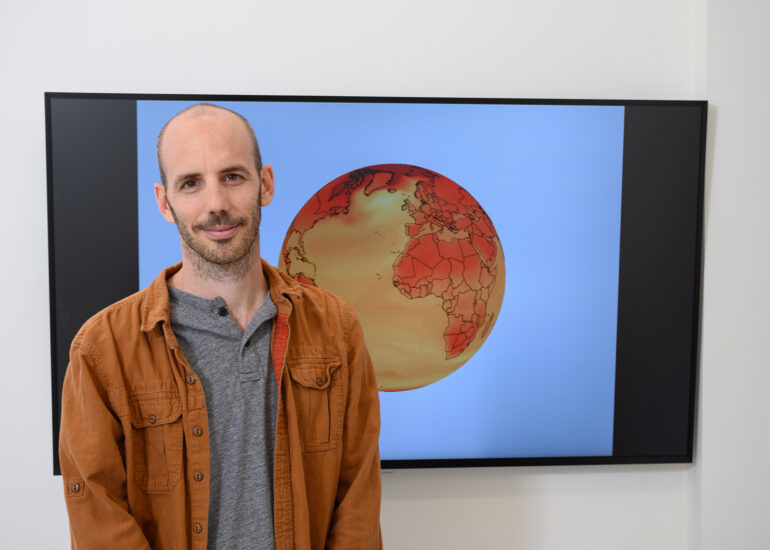About 30 massive, intricate computer networks serve the scientists who stand at the forefront of climate change research. Each network runs a software program comprised of millions of lines of code. These programs are computational models that combine the myriads of physical, chemical and biological phenomena that together form the climate of our planet. The models calculate the state of Earth’s atmosphere, oceans, land and ice, capturing past and present climate variability and using the data to predict future climate change. These results are analyzed by leading research institutes across the globe, including the Weizmann Institute of Science, and then incorporated into the UN’s Intergovernmental Panel on Climate Change (IPCC) assessment report. Policymakers rely on the IPCC report when they form adaptation and mitigation strategies for climate change, one of our generation’s greatest crises.
A new study, published today in Nature Climate Change, will certainly make the IPCC—and other environmental bodies—take notice. A team of scientists led by Dr. Rei Chemke of Weizmann’s Earth and Planetary Sciences Department revealed a considerable intensification of winter storms in the Southern Hemisphere. The study, conducted in collaboration with Dr. Yi Ming of Princeton University and Dr. Janni Yuval of MIT, is sure to make waves in the climate conversation. Until now, climate models have projected a human-caused intensification of winter storms only toward the end of this century. In the new study, Chemke and his team compared climate model simulations with current storm observations. Their discovery was bleak: It became clear that storm intensification over recent decades has already reached levels projected to occur in the year 2080.
“A winter storm is a weather phenomenon that lasts only a few days. Individually, each storm doesn’t carry much climatic weight. However, the long-term effect of winter storms becomes evident when assessing cumulative data collected over long periods of time,” Chemke explains. Cumulatively, these storms have a significant impact, affecting the transfer of heat, moisture and momentum within the atmosphere, which consequently affects the various climate zones on Earth. “One example of this is the role the storms play in regulating the temperature at the Earth’s poles. Winter storms are responsible for the majority of the heat transport away from tropical regions toward the poles. Without their contribution, the average pole temperatures would be about 30°C lower.” Similarly, the collective intensification of these storms yields a real and significant threat to societies in the Southern Hemisphere in the next decades.
“We chose to focus on the Southern Hemisphere because the intensification registered there has been stronger than in the Northern Hemisphere,” Chemke says. “We didn’t examine the Northern Hemisphere, but it seems that the intensification of storms in this hemisphere is slower compared to that in the Southern Hemisphere. If the trend persists,” Chemke adds, “we will be observing more significant winter storm intensification here in the upcoming years and decades.”
In his lab at the Weizmann Institute, Chemke researches the physical mechanisms underlying large-scale climate change. In this study, he and his research partners sought to understand whether these changes in climate patterns were caused by external factors (such as human activity), or whether they have resulted from the internal fluctuations of the global climate system. They analyzed climate models that simulated storm intensification patterns under the isolated influence of internal climatic causes, without external impact. They showed that over the past 20 years, storms have been intensifying faster than can be explained by internal climatic behavior alone.
In addition, the researchers discovered the physical process behind the storm intensification. An analysis of the growth rate of the storms showed that changes in atmospheric jet streams over the past few decades have caused these escalations, and current climate models are unable to reflect these changes accurately.
Chemke, Ming and Yuval’s study has two immediate, considerable implications. First, it shows that not only climate projections for the coming decades are graver than previous assessments, but it also suggests that human activity might have a greater impact on the Southern Hemisphere than previously estimated. This means that rapid and decisive intervention is required in order to halt the climate damage in this region. Second, a correction of the bias in climate models is in order, so that these can provide a more accurate climate projection in the future.
Could the climate models be inaccurately predicting other important phenomena? “The models are doing a very good job at forecasting nearly all the parameters,” Chemke says. “We’ve discovered one parameter for which the sensitivity of the models needs to be adjusted. Changes in temperature, precipitation, sea ice, and summer storm patterns, for example, are all being simulated accurately.”
The study’s findings are expected to help climate researchers around the world correct the bias in the models and create a more accurate prediction of future climate patterns. In addition, the updated understanding of the intensification of winter storms over the past several decades will help us gain a better understanding of the state of the Earth’s climate. Climate scientists will now be able to estimate more accurately the extent of the damage that climate change is expected to wreak—damage that will only be mitigated if humanity intervenes and takes responsibility for the future of the planet.
More information:
Rei Chemke, The intensification of winter mid-latitude storm tracks in the Southern Hemisphere, Nature Climate Change (2022). DOI: 10.1038/s41558-022-01368-8. www.nature.com/articles/s41558-022-01368-8
Provided by
Weizmann Institute of Science
Citation:
New data reveals climate change might be more rapid than predicted (2022, May 26)



